What Is the Minimum Stopping Distance for the Same Car Traveling at a Speed of 36.0 M/s ?
Chapter 2 One-Dimensional Kinematics
11 two.5 Move Equations for Constant Dispatch in Ane Dimension
Summary
- Calculate displacement of an object that is not dispatch, given initial position and velocity.
- Calculate terminal velocity of an accelerating object, given initial velocity, acceleration, and time.
- Calculate displacement and final position of an accelerating object, given initial position, initial velocity, time, and acceleration.
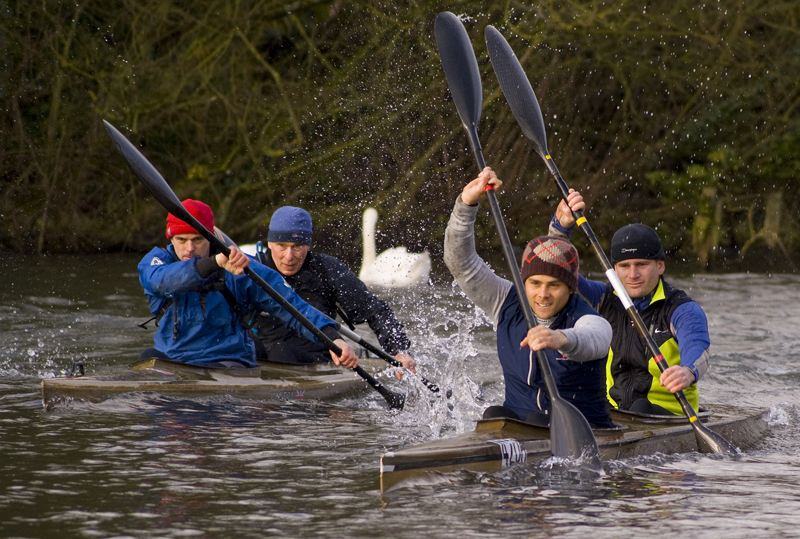
We might know that the greater the acceleration of, say, a automobile moving away from a cease sign, the greater the displacement in a given fourth dimension. Only we have non developed a specific equation that relates acceleration and displacement. In this section, nosotros develop some user-friendly equations for kinematic relationships, starting from the definitions of displacement, velocity, and acceleration already covered.
Notation: t, x, v, a
Showtime, permit us make some simplifications in annotation. Taking the initial fourth dimension to be zero, as if fourth dimension is measured with a stopwatch, is a great simplification. Since elapsed time is[latex]\boldsymbol{\Delta{t}={t_f}-{t_0}}[/latex], taking[latex]\boldsymbol{t_0=0}[/latex] means that[latex]\boldsymbol{\Delta{t}={t_f}}[/latex], the final time on the stopwatch. When initial time is taken to be zero, we use the subscript 0 to announce initial values of position and velocity. That is,[latex]\boldsymbol{x_0}[/latex]is the initial position and[latex]\boldsymbol{v_0}[/latex]is the initial velocity. We put no subscripts on the last values. That is,[latex]\boldsymbol{t}[/latex]is the final time,[latex]\boldsymbol{x}[/latex]is the final position, and[latex]\boldsymbol{5}[/latex] is the last velocity. This gives a simpler expression for elapsed fourth dimension—now,[latex]\boldsymbol{\Delta{t}=t}[/latex]. It likewise simplifies the expression for deportation, which is at present[latex]\boldsymbol{\Delta{x}={ten}-{x_0}}[/latex]. As well, it simplifies the expression for change in velocity, which is now[latex]\boldsymbol{\Delta{v}={v}-{v_0}}[/latex]. To summarize, using the simplified notation, with the initial time taken to be zero,
[latex]\begin{array}{lcl} \boldsymbol{\Delta{t}} & = & \boldsymbol{t} \\ \boldsymbol{\Delta{x}} & = & \boldsymbol{x-x_0} \\ \boldsymbol{\Delta{v}} & = & \boldsymbol{v-v_0} \end{array}[/latex][latex]\rbrace[/latex]
where the subscript 0 denotes an initial value and the absence of a subscript denotes a final value in any move is under consideration.
We at present make the important supposition that acceleration is constant. This assumption allows united states of america to avert using calculus to discover instantaneous dispatch. Since dispatch is constant, the boilerplate and instantaneous accelerations are equal. That is,
[latex]\boldsymbol{\bar{a}=a=\textbf{constant,}}[/latex]
so we apply the symbol[latex]\textbf{a}[/latex]for acceleration at all times. Assuming dispatch to be abiding does not seriously limit the situations we tin report nor degrade the accuracy of our treatment. For one affair, acceleration is abiding in a great number of situations. Furthermore, in many other situations we can accurately describe movement by bold a abiding acceleration equal to the average acceleration for that motility. Finally, in motions where acceleration changes drastically, such as a auto accelerating to summit speed and and so braking to a stop, the movement tin be considered in separate parts, each of which has its own constant acceleration.
SOLVING FOR Displacement (Δten) AND FINAL POSITION (x) FROM Average VELOCITY WHEN Acceleration (a) IS Abiding
To become our kickoff two new equations, we first with the definition of average velocity:
[latex]\boldsymbol{\bar{v}=}[/latex][latex]\boldsymbol{\frac{\Delta{x}}{\Delta{t}}}[/latex].
Substituting the simplified notation for[latex]\boldsymbol{\Delta{ten}}[/latex]and[latex]\boldsymbol{\Delta{t}}[/latex]yields
[latex]\boldsymbol{\bar{v}=}[/latex][latex]\boldsymbol{\frac{x-x_0}{t}}[/latex].
Solving for[latex]\boldsymbol{x}[/latex]yields
[latex]\boldsymbol{x=x_0+\bar{five}t}[/latex],
where the average velocity is
[latex]\boldsymbol{\bar{v}=}[/latex][latex]\boldsymbol{\frac{v_0+v}{2}}[/latex][latex]\boldsymbol{(\textbf{constant} \; a)}[/latex].
The equation [latex]\boldsymbol{\bar{v}=}[/latex][latex]\boldsymbol{\frac{{v}_0+{v}}{2}}[/latex]reflects the fact that, when acceleration is constant,[latex]\boldsymbol{five}[/latex]is just the simple average of the initial and final velocities. For example, if you steadily increase your velocity (that is, with constant dispatch) from 30 to sixty km/h, then your boilerplate velocity during this steady increase is 45 km/h. Using the equation [latex]\boldsymbol{\bar{v}=}[/latex][latex]\boldsymbol{\frac{{v}_0+{five}}{2}}[/latex] to bank check this, nosotros see that
[latex]\boldsymbol{\bar{5}=}[/latex][latex]\boldsymbol{\frac{{five}_0 + {v}}{two}}[/latex][latex]\boldsymbol{=}[/latex][latex]\boldsymbol{\frac{30\textbf{ km/h} + lx\textbf{ km/h}}{2}}[/latex][latex]\boldsymbol{=45\textbf{ km/h}}[/latex],
which seems logical.
Case 1: Calculating Displacement: How Far does the Jogger Run?
A jogger runs down a straight stretch of road with an boilerplate velocity of four.00 thou/s for two.00 min. What is his last position, taking his initial position to be zero?
Strategy
Draw a sketch.

The final position[latex]\boldsymbol{x}[/latex]is given past the equation
[latex]\boldsymbol{{x}={x}_0+\bar{v}{t}}[/latex].
To find[latex]\boldsymbol{x}[/latex], nosotros place the values of[latex]\boldsymbol{x_0}[/latex],[latex]\boldsymbol{\bar{v}}[/latex], and[latex]\boldsymbol{t}[/latex] from the statement of the trouble and substitute them into the equation.
Solution
1. Identify the knowns.[latex]\boldsymbol{\bar{v}=four.00\textbf{ m/due south}}[/latex],[latex]\boldsymbol{\Delta{t}=2.00\textbf{ min}}[/latex], and[latex]\boldsymbol{{ten}_0=0\textbf{ m}}[/latex].
2. Enter the known values into the equation.
[latex]\boldsymbol{{x}={x}_0+\bar{5}{t}=\:0+\:(4.00\textbf{ thou/s})(120\textbf{ s})=480\textbf{ m}}[/latex]
Word
Velocity and last displacement are both positive, which ways they are in the same direction.
The equation[latex]\boldsymbol{{x}={x}_0+\bar{v}{t}}[/latex]gives insight into the relationship betwixt deportation, average velocity, and time. It shows, for example, that deportation is a linear office of boilerplate velocity. (Past linear function, nosotros hateful that deportation depends on[latex]\boldsymbol{\bar{v}}[/latex] rather than on[latex]\boldsymbol{\bar{v}}[/latex]raised to some other power, such equally[latex]\boldsymbol{\bar{5}^2}[/latex]. When graphed, linear functions await like direct lines with a constant slope.) On a car trip, for example, we will get twice every bit far in a given fourth dimension if nosotros average ninety km/h than if nosotros average 45 km/h.
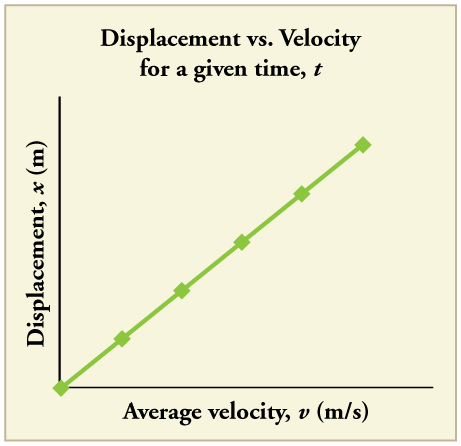
SOLVING FOR FINAL VELOCITY
We can derive some other useful equation by manipulating the definition of acceleration.
[latex]\boldsymbol{{a}=}[/latex][latex]\boldsymbol{\frac{\Delta{5}}{\Delta{t}}}[/latex]
Substituting the simplified notation for[latex]\boldsymbol{\Delta{v}}[/latex]and[latex]\boldsymbol{\Delta{t}}[/latex]gives us
[latex]\boldsymbol{a=}[/latex][latex]\boldsymbol{\frac{{5}-{5}_0}{t}}[/latex][latex]\boldsymbol{(\textbf{constant }a)}[/latex].
Solving for[latex]\boldsymbol{v}[/latex]yields
[latex]\boldsymbol{{5}={v}_0+at\:(\textbf{constant }a)}[/latex].
Example 2: Calculating Final Velocity: An Airplane Slowing Down after Landing
An aeroplane lands with an initial velocity of 70.0 thou/s and so decelerates at[latex]\boldsymbol{1.50\textbf{ one thousand/southward}^2}[/latex] for xl.0 s. What is its last velocity?
Strategy
Describe a sketch. Nosotros draw the acceleration vector in the direction opposite the velocity vector because the airplane is decelerating.
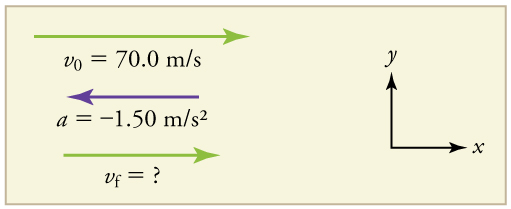
Solution
1. Identify the knowns.[latex]\boldsymbol{{v}_0=70.0\textbf{ m/s}}[/latex],[latex]\boldsymbol{{a}=-1.l\textbf{ m/s}^ii}[/latex],[latex]\boldsymbol{{t}=40.0 \textbf{ south}}[/latex].
2. Identify the unknown. In this case, information technology is final velocity,[latex]\boldsymbol{v_f}[/latex].
3. Determine which equation to apply. We can summate the final velocity using the equation[latex]\boldsymbol{five=v_0+at}[/latex].
4. Plug in the known values and solve.
[latex]\boldsymbol{v=v_0+at=seventy.0\textbf{ m/southward}+(-1.50\textbf{ g/south}^2)(40.0\textbf{ southward})=10.0\textbf{ m/south}}[/latex]
Discussion
The terminal velocity is much less than the initial velocity, as desired when slowing down, simply still positive. With jet engines, contrary thrust could be maintained long enough to end the airplane and start moving information technology backward. That would be indicated past a negative last velocity, which is not the case hither.

In improver to existence useful in problem solving, the equation[latex]\boldsymbol{v=v_0+at}[/latex] gives us insight into the relationships among velocity, acceleration, and fourth dimension. From it we tin run across, for example, that
- final velocity depends on how large the acceleration is and how long it lasts
- if the acceleration is zero, and so the concluding velocity equals the initial velocity[latex]\boldsymbol{(v=v_0)}[/latex], equally expected (i.e., velocity is constant)
- if[latex]\boldsymbol{a}[/latex]is negative, then the final velocity is less than the initial velocity
(All of these observations fit our intuition, and it is always useful to examine basic equations in light of our intuition and experiences to cheque that they do indeed describe nature accurately.)
MAKING CONNECTIONS: REAL Earth CONNECTION

An intercontinental ballistic missile (ICBM) has a larger average acceleration than the Space Shuttle and achieves a greater velocity in the first minute or two of flight (bodily ICBM burn times are classified—brusque-burn-fourth dimension missiles are more hard for an enemy to destroy). But the Infinite Shuttle obtains a greater concluding velocity, and then that information technology tin orbit the world rather than come directly back down as an ICBM does. The Infinite Shuttle does this by accelerating for a longer time.
SOLVING FOR FINAL POSITION WHEN VELOCITY IS Not CONSTANT ( a ≠ 0 )
We can combine the equations in a higher place to find a 3rd equation that allows the states to calculate the final position of an object experiencing abiding dispatch. Nosotros start with
[latex]\boldsymbol{five=v_0+at}[/latex].
Adding[latex]\boldsymbol{v_0}[/latex]to each side of this equation and dividing past 2 gives
[latex]\boldsymbol{\frac{v_0+\:five}{2}}[/latex][latex]\boldsymbol{=v_0+}[/latex][latex]\boldsymbol{\frac{ane}{2}}[/latex][latex]\boldsymbol{at}[/latex]
Since[latex]\boldsymbol{\frac{v_0+v}{2}=\bar{v}}[/latex] for abiding acceleration, then
[latex]\boldsymbol{\bar{v}=v_0+}[/latex][latex]\boldsymbol{\frac{1}{2}}[/latex][latex]\boldsymbol{at}[/latex].
Now we substitute this expression for[latex]\boldsymbol{\bar{v}}[/latex]into the equation for displacement,[latex]\boldsymbol{ten=x_0+\bar{v}t}[/latex], yielding
[latex]\boldsymbol{ten=x_0+v_0t+}[/latex][latex]\boldsymbol{\frac{1}{2}}[/latex][latex]\boldsymbol{at^ii(\textbf{constant }a)}[/latex].
Example 3: Calculating Deportation of an Accelerating Object: Dragsters
Dragsters can achieve boilerplate accelerations of[latex]\boldsymbol{26.0\textbf{ thou/southward}^ii}[/latex]. Suppose such a dragster accelerates from residual at this rate for 5.56 southward. How far does it travel in this time?
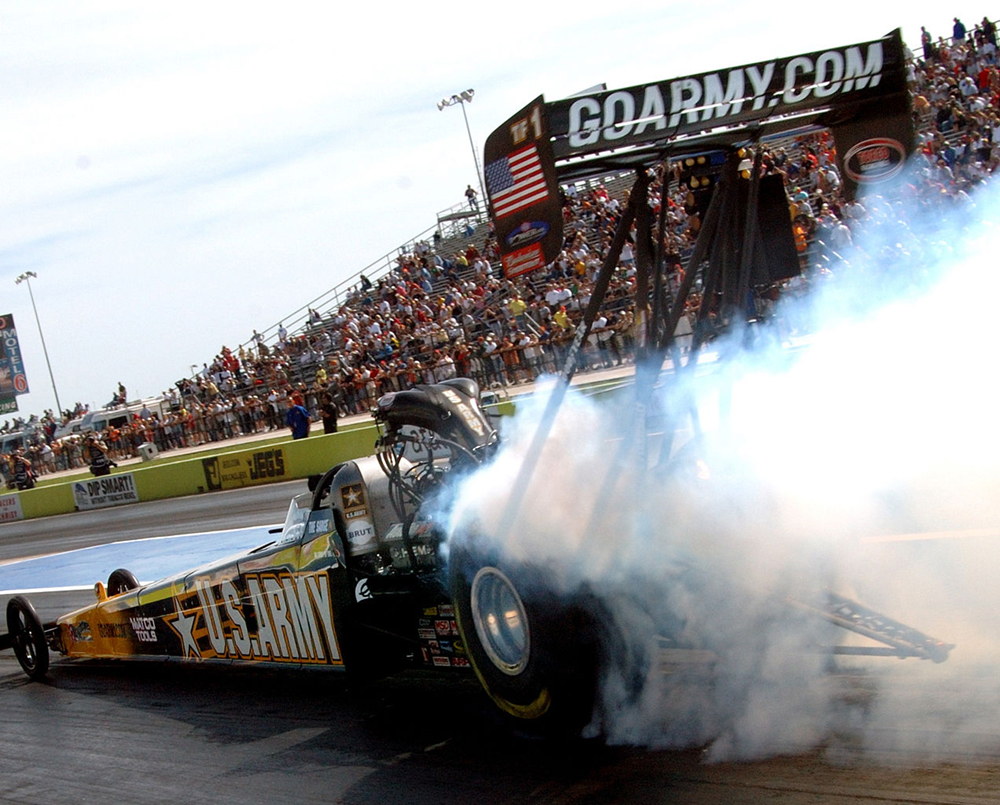
Strategy
Draw a sketch.

We are asked to observe displacement, which is[latex]\boldsymbol{x}[/latex]if we accept[latex]\boldsymbol{x_0}[/latex]to be zero. (Think near it like the starting line of a race. Information technology tin be anywhere, merely we call it 0 and measure out all other positions relative to information technology.) Nosotros tin can utilize the equation[latex]\boldsymbol{x=x_0+v_0t+\frac{1}{2}at^two}[/latex]once nosotros place[latex]\boldsymbol{v_0}[/latex],[latex]\boldsymbol{a}[/latex], and[latex]\boldsymbol{t}[/latex]from the statement of the problem.
Solution
i. Identify the knowns. Starting from rest ways that[latex]\boldsymbol{v_0=0}[/latex],[latex]\boldsymbol{a}[/latex]is given as[latex]\boldsymbol{26.0 \textbf{thousand/s}^two}[/latex] and[latex]\boldsymbol{t}[/latex]is given equally 5.56 s.
two. Plug the known values into the equation to solve for the unknown[latex]\textbf{x}[/latex]:
[latex]\boldsymbol{x=x_0+v_0t+\frac{1}{2}at^ii}[/latex].
Since the initial position and velocity are both zero, this simplifies to
[latex]\boldsymbol{10=\frac{i}{2}at^2}[/latex].
Substituting the identified values of[latex]\boldsymbol{a}[/latex]and[latex]\boldsymbol{t}[/latex]gives
[latex]\boldsymbol{x=\frac{one}{2}(26.0\textbf{ k/s}^2)(5.56\textbf{ due south})^ii}[/latex],
yielding
[latex]\boldsymbol{x=402\textbf{ yard}}[/latex].
Discussion
If we convert 402 thou to miles, we find that the altitude covered is very close to 1 quarter of a mile, the standard distance for drag racing. And so the answer is reasonable. This is an impressive deportation in but five.56 southward, but superlative-notch dragsters can do a quarter mile in even less time than this.
What else tin can nosotros learn by examining the equation[latex]\boldsymbol{x=x_0+v_0t+\frac{1}{2}at^2}[/latex]? Nosotros meet that:
- displacement depends on the square of the elapsed time when acceleration is not zero. In Example iii, the dragster covers only i fourth of the total distance in the first one-half of the elapsed time
- if dispatch is zero, then the initial velocity equals average velocity[latex]\boldsymbol{(v_0=\bar{v})}[/latex]and[latex]\boldsymbol{10=x_0+v_0t+\frac{1}{2}at^ii}[/latex]becomes[latex]\boldsymbol{ten=x_0+v_0t}[/latex]
SOLVING FOR Terminal VELOCITY WHEN VELOCITY IS Non CONSTANT ( a ≠ 0 )
A fourth useful equation tin exist obtained from another algebraic manipulation of previous equations.
If we solve[latex]\boldsymbol{v=v_0+at}[/latex]for[latex]\boldsymbol{t}[/latex], we go
[latex]\boldsymbol{t=}[/latex][latex]\boldsymbol{\frac{v-v_0}{a}}[/latex].
Substituting this and[latex]\boldsymbol{\bar{five}=\frac{v_0+v}{2}}[/latex]into[latex]\boldsymbol{x=x_0+\bar{five}t}[/latex], we get
[latex]\boldsymbol{five^2=v_0^ii+2a(x-x_0)(\textbf{constant }a)}[/latex].Instance: Calculating Terminal Velocity: Dragsters
Example iv: Calculating Final Velocity: Dragsters
Calculate the final velocity of the dragster in Example three without using information about time.
Strategy
Describe a sketch.

The equation[latex]\boldsymbol{v^2=v_0^two+2a(x-x_0)}[/latex] is ideally suited to this task because it relates velocities, acceleration, and displacement, and no time information is required.
Solution
1. Identify the known values. We know that[latex]\boldsymbol{v_0=0}[/latex], since the dragster starts from rest. So we note that[latex]\boldsymbol{ten-x_0=402\textbf{ thousand}}[/latex] (this was the answer in Example iii). Finally, the average acceleration was given to exist[latex]\boldsymbol{a=26.0\textbf{ m/due south}^2}[/latex].
2. Plug the knowns into the equation[latex]\boldsymbol{v^2=v_0^2+2a(ten-x_0)}[/latex]and solve for[latex]\boldsymbol{5}[/latex].
[latex]\boldsymbol{five^2=0+two(26.0\textbf{ m/s}^2)(402\textbf{ m}).}[/latex]
Thus
[latex]\boldsymbol{five^2=two.09\times10^four\textbf{ grand}^2\textbf{/}\textbf{ southward}^2}[/latex]
To get[latex]\textbf{5}[/latex], we take the square root:
[latex]\boldsymbol{v=\sqrt{two.09\times10^iv\textbf{ k}^2/\textbf{ s}^2}=145\textbf{ thousand/s}}[/latex].
Word
145 k/s is about 522 km/h or nigh 324 mi/h, but even this breakneck speed is curt of the record for the quarter mile. Too, annotation that a foursquare root has ii values; we took the positive value to bespeak a velocity in the same direction as the acceleration.
An exam of the equation[latex]\boldsymbol{5^2=v_0^ii+2a(x-x_0)}[/latex] tin can produce farther insights into the general relationships among concrete quantities:
- The final velocity depends on how large the acceleration is and the distance over which it acts
- For a stock-still deceleration, a car that is going twice as fast doesn't simply stop in twice the distance—it takes much further to terminate. (This is why nosotros accept reduced speed zones near schools.)
Putting Equations Together
In the following examples, nosotros further explore one-dimensional move, but in situations requiring slightly more algebraic manipulation. The examples also give insight into problem-solving techniques. The box below provides easy reference to the equations needed.
SUMMARY OF KINEMATIC EQUATIONS(CONSTANT a)
[latex]\boldsymbol{ten=x_0+\bar{v}t}[/latex]
[latex]\boldsymbol{\bar{5}=}[/latex][latex]\boldsymbol{\frac{v_0+v}{ii}}[/latex]
[latex]\boldsymbol{5=v_0+at}[/latex]
[latex]\boldsymbol{ten=x_0+v_0t+}[/latex][latex]\boldsymbol{\frac{ane}{ii}}[/latex][latex]\boldsymbol{at^2}[/latex]
[latex]\boldsymbol{v^2=v_0^ii+2a(ten-x_0)}[/latex]
Case v: Calculating Displacement: How Far Does a Car Get When Coming to a Halt?
On dry concrete, a car can decelerate at a rate of[latex]\boldsymbol{7.00\textbf{ m/south}^two}[/latex], whereas on wet physical it tin can decelerate at just[latex]\boldsymbol{five.00\textbf{ m/south}^2}[/latex]. Find the distances necessary to stop a machine moving at 30.0 g/s (nearly 110 km/h) (a) on dry physical and (b) on moisture concrete. (c) Echo both calculations, finding the displacement from the indicate where the driver sees a traffic light turn cherry-red, taking into account his reaction fourth dimension of 0.500 s to go his pes on the brake.
Strategy
Draw a sketch.
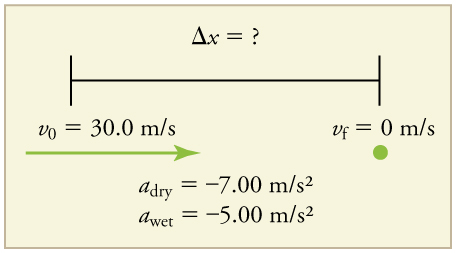
In order to make up one's mind which equations are all-time to use, we need to list all of the known values and identify exactly what we demand to solve for. Nosotros shall do this explicitly in the next several examples, using tables to set them off.
Solution for (a)
1. Place the knowns and what we desire to solve for. Nosotros know that[latex]\boldsymbol{v_0=thirty.0\textbf{ m/s}}[/latex];[latex]\boldsymbol{v=0}[/latex];[latex]\boldsymbol{a=-vii.00\textbf{ grand/s}^2}[/latex]([latex]\boldsymbol{a}[/latex] is negative considering it is in a management reverse to velocity). Nosotros have[latex]\boldsymbol{x_0}[/latex]to be 0. We are looking for displacement[latex]\boldsymbol{\Delta{ten}}[/latex], or[latex]\boldsymbol{x-x_0}[/latex].
2. Identify the equation that will help up solve the trouble. The all-time equation to use is
[latex]\boldsymbol{v^two=v_0^two+2a(10-x_0)}[/latex].
This equation is best because information technology includes merely i unknown,[latex]\boldsymbol{x}[/latex]. We know the values of all the other variables in this equation. (There are other equations that would allow u.s. to solve for[latex]\boldsymbol{10}[/latex], only they require us to know the stopping time,[latex]\boldsymbol{t}[/latex], which we practice not know. Nosotros could use them but it would entail additional calculations.)
3. Rearrange the equation to solve for[latex]\textbf{10}[/latex].
[latex]\boldsymbol{ten-x_0=}[/latex][latex]\boldsymbol{\frac{v^2-v_0^two}{2a}}[/latex]
4. Enter known values.
[latex]\boldsymbol{\textbf{10}-0=}[/latex][latex]\boldsymbol{\frac{0^ii-(30.0\textbf{ chiliad/s})^2}{ii(-7.00\textbf{ m/s}^2)}}[/latex]
Thus,
[latex]\boldsymbol{x=64.3\textbf{ chiliad on dry out concrete.}}[/latex]
Solution for (b)
This office can exist solved in exactly the same manner every bit Part A. The only divergence is that the deceleration is[latex]\boldsymbol{-5.00\textbf{ m/s}^two}[/latex]. The result is
[latex]\boldsymbol{x_{wet}=90.0\textbf{ m on wet concrete.}}[/latex]
Solution for (c)
Once the driver reacts, the stopping distance is the same equally it is in Parts A and B for dry and wet physical. And then to answer this question, we demand to summate how far the car travels during the reaction time, and and then add that to the stopping time. Information technology is reasonable to assume that the velocity remains constant during the commuter's reaction time.
1. Identify the knowns and what nosotros want to solve for. Nosotros know that[latex]\boldsymbol{\bar{v}=thirty.0\textbf{ m/due south}}[/latex];[latex]\boldsymbol{t_{reaction}=0.500\textbf{ due south}}[/latex];[latex]\boldsymbol{a_{reaction}=0}[/latex]. We have[latex]\boldsymbol{x_{0-reaction}}[/latex] to be 0. We are looking for[latex]\boldsymbol{x_{reaction}}[/latex].
two. Identify the best equation to use.
[latex]\boldsymbol{x=x_0+\bar{v}t}[/latex]works well considering the only unknown value is[latex]\boldsymbol{x}[/latex], which is what nosotros want to solve for.
iii. Plug in the knowns to solve the equation.
[latex]\boldsymbol{x=0+(thirty.0\textbf{ m/s})(0.500\textbf{ southward})=15.0\textbf{ m}}[/latex].
This means the car travels fifteen.0 m while the driver reacts, making the total displacements in the 2 cases of dry and moisture physical 15.0 m greater than if he reacted instantly.
iv. Add together the displacement during the reaction fourth dimension to the displacement when braking.
[latex]\boldsymbol{x_{braking}+x_{reaction}=x_{total}}[/latex]
(a) 64.iii m + fifteen.0 m = 79.3 m when dry out
(b) 90.0 m + xv.0 m = 105 m when wet
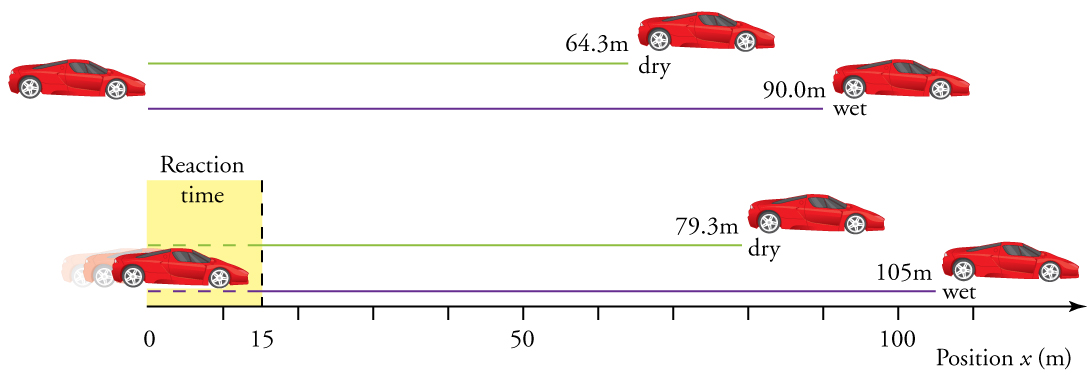
Word
The displacements found in this case seem reasonable for stopping a fast-moving car. It should accept longer to end a auto on wet rather than dry out pavement. It is interesting that reaction time adds significantly to the displacements. Merely more important is the general approach to solving problems. We identify the knowns and the quantities to be determined and and so find an appropriate equation. At that place is often more one manner to solve a trouble. The various parts of this example can in fact exist solved past other methods, just the solutions presented above are the shortest.
Example 6: Calculating Time: A Car Merges into Traffic
Suppose a auto merges into state highway traffic on a 200-m-long ramp. If its initial velocity is 10.0 m/s and information technology accelerates at[latex]\boldsymbol{2.00\textbf{ 1000/southward}^ii}[/latex], how long does it take to travel the 200 m up the ramp? (Such information might be useful to a traffic engineer.)
Strategy
Draw a sketch.
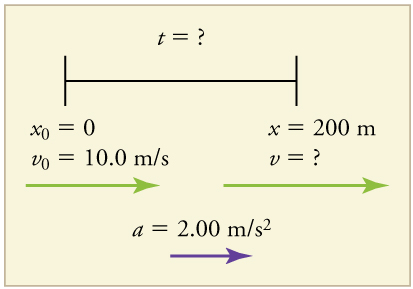
We are asked to solve for the time[latex]\boldsymbol{t}[/latex]. Every bit before, we place the known quantities in order to choose a convenient physical relationship (that is, an equation with one unknown,[latex]\boldsymbol{t}[/latex]).
Solution
1. Identify the knowns and what we want to solve for. We know that[latex]\boldsymbol{v_0=10\textbf{ thousand/s}}[/latex];[latex]\boldsymbol{a=2.00\textbf{ m/s}^two}[/latex]; and[latex]\boldsymbol{x=200\textbf{ thousand}}[/latex].
2. We need to solve for[latex]\boldsymbol{t}[/latex]. Choose the all-time equation.[latex]\boldsymbol{x=x_0+v_0t+\frac{i}{2}at^ii}[/latex] works all-time because the only unknown in the equation is the variable[latex]\boldsymbol{t}[/latex] for which we demand to solve.
iii. Nosotros will need to rearrange the equation to solve for[latex]\boldsymbol{t}[/latex]. In this case, information technology will be easier to plug in the knowns first.
[latex]\boldsymbol{200\textbf{ m}=0\textbf{ m}+(10.0\textbf{ 1000/s})t+\frac{1}{2}(2.00\textbf{ m/southward}^2)t^2}[/latex]
iv. Simplify the equation. The units of meters (m) cancel because they are in each term. We can get the units of seconds (s) to cancel by taking[latex]\boldsymbol{\textbf{t}=\textbf{t southward}}[/latex], where[latex]\textbf{t}[/latex] is the magnitude of time and due south is the unit. Doing so leaves
[latex]\boldsymbol{200=10t+t^2}[/latex].
5. Apply the quadratic formula to solve for[latex]\boldsymbol{t}[/latex].
(a) Rearrange the equation to get 0 on one side of the equation.
[latex]\boldsymbol{t^two+10t-200=0}[/latex]
This is a quadratic equation of the grade
[latex]\boldsymbol{at^2+bt+c=0,}[/latex]
where the constants are[latex]\boldsymbol{a=1.00\textbf{, }b=10.0\textbf{, and }c=-200}[/latex].
(b) Its solutions are given by the quadratic formula:
[latex]\boldsymbol{t=}[/latex][latex]\boldsymbol{\frac{-b\pm\sqrt{b^2-4ac}}{2a}}[/latex].
This yields two solutions for[latex]\boldsymbol{t}[/latex], which are
[latex]\boldsymbol{t=ten.0\textbf{ and }-20.0.}[/latex]
In this case, so, the time is[latex]\boldsymbol{t=t}[/latex] in seconds, or
[latex]\boldsymbol{t=10.0\textbf{ due south and }-20.0\textbf{ southward.}}[/latex]
A negative value for time is unreasonable, since it would mean that the event happened twenty s before the movement began. We can discard that solution. Thus,
[latex]\boldsymbol{t=10.0\textbf{ south.}}[/latex]
Word
Whenever an equation contains an unknown squared, there volition exist two solutions. In some problems both solutions are meaningful, but in others, such as the above, only one solution is reasonable. The 10.0 s answer seems reasonable for a typical freeway on-ramp.
With the basics of kinematics established, we can get on to many other interesting examples and applications. In the procedure of developing kinematics, we have as well glimpsed a general approach to problem solving that produces both correct answers and insights into concrete relationships. Affiliate 2.6 Trouble-Solving Basics discusses problem-solving nuts and outlines an approach that will help you lot succeed in this invaluable task.
MAKING CONNECTIONS: Accept-HOME EXPERIMENT–BREAKING NEWS
We take been using SI units of meters per 2d squared to describe some examples of dispatch or deceleration of cars, runners, and trains. To achieve a meliorate feel for these numbers, one can measure out the braking deceleration of a motorcar doing a slow (and safe) end. Recall that, for boilerplate acceleration,[latex]\boldsymbol{\bar{a}=\Delta{v}/\Delta{t}}[/latex]. While traveling in a automobile, slowly utilise the brakes as you come upwardly to a end sign. Have a passenger note the initial speed in miles per hour and the fourth dimension taken (in seconds) to terminate. From this, calculate the deceleration in miles per hour per 2d. Convert this to meters per second squared and compare with other decelerations mentioned in this chapter. Calculate the altitude traveled in braking.
Check Your Understanding
one: A manned rocket accelerates at a rate of[latex]\boldsymbol{20\textbf{chiliad/south}^2}[/latex]during launch. How long does it take the rocket to achieve a velocity of 400 m/s?
Department Summary
- To simplify calculations we take dispatch to be constant, and so that[latex]\boldsymbol{\bar{a}=a}[/latex] at all times.
- We also take initial time to be zero.
- Initial position and velocity are given a subscript 0; final values accept no subscript. Thus,
[latex]\begin{array}{lcl} \boldsymbol{\Delta{t}} & = & \boldsymbol{t} \\ \boldsymbol{\Delta{x}} & = & \boldsymbol{10-x_0} \\ \boldsymbol{\Delta{5}} & = & \boldsymbol{v-v_0} \end{array}[/latex][latex]\rbrace[/latex]
- The following kinematic equations for motion with abiding[latex]\boldsymbol{a}[/latex]are useful:
[latex]\boldsymbol{x=x_0+\bar{v}t}[/latex]
[latex]\boldsymbol{\bar{5}=}[/latex][latex]\boldsymbol{\frac{v_0+v}{2}}[/latex]
[latex]\boldsymbol{v=v_0+at}[/latex]
[latex]\boldsymbol{x=x_0+v_0t+}[/latex][latex]\boldsymbol{\frac{i}{2}}[/latex][latex]\boldsymbol{at^2}[/latex]
[latex]\boldsymbol{v^ii=v_0^ii+2a(x-x_0)}[/latex]
- In vertical motility,[latex]\boldsymbol{y}[/latex]is substituted for[latex]\boldsymbol{x}[/latex].
Problems & Exercises
ane: An Olympic-class sprinter starts a race with an dispatch of[latex]\boldsymbol{4.50\textbf{ chiliad/s}^2}[/latex]. (a) What is her speed ii.xl s after? (b) Sketch a graph of her position vs. time for this menstruation.
ii: A well-thrown ball is caught in a well-padded hand. If the deceleration of the ball is[latex]\boldsymbol{2.10\times10^4\textbf{ m/s}^two}[/latex], and i.85 ms[latex]\boldsymbol{(1\textbf{ ms}=10^{-three}\textbf{ s})}[/latex]elapses from the time the ball first touches the mitt until information technology stops, what was the initial velocity of the brawl?
3: A bullet in a gun is accelerated from the firing bedchamber to the cease of the barrel at an average rate of[latex]\boldsymbol{half dozen.20\times10^v\textbf{ m/s}^2}[/latex]for[latex]\boldsymbol{8.ten\times10^{-4}\textbf{ southward}}[/latex]. What is its muzzle velocity (that is, its final velocity)?
4: (a) A calorie-free-rail driver train accelerates at a rate of[latex]\boldsymbol{ane.35\textbf{ m/s}^2}[/latex]. How long does it take to reach its height speed of 80.0 km/h, starting from rest? (b) The same railroad train ordinarily decelerates at a rate of[latex]\boldsymbol{1.65\textbf{ chiliad/s}^ii}[/latex]. How long does it take to come to a stop from its summit speed? (c) In emergencies the railroad train can decelerate more than rapidly, coming to residue from 80.0 km/h in 8.30 s. What is its emergency deceleration in[latex]\boldsymbol{\textbf{m/southward}^2}[/latex]?
five: While entering a state highway, a car accelerates from balance at a rate of[latex]\boldsymbol{2.40\textbf{ chiliad/s}^2}[/latex]for 12.0 s. (a) Draw a sketch of the state of affairs. (b) List the knowns in this problem. (c) How far does the auto travel in those 12.0 south? To solve this part, get-go identify the unknown, and and so talk over how you lot chose the appropriate equation to solve for it. Later choosing the equation, prove your steps in solving for the unknown, check your units, and hash out whether the answer is reasonable. (d) What is the automobile's concluding velocity? Solve for this unknown in the aforementioned mode equally in part (c), showing all steps explicitly.
6: At the end of a race, a runner decelerates from a velocity of 9.00 thousand/south at a rate of[latex]\boldsymbol{ii.00\textbf{ m/due south}^2}[/latex]. (a) How far does she travel in the adjacent 5.00 s? (b) What is her final velocity? (c) Evaluate the result. Does it make sense?
seven: Professional person Application:
Claret is accelerated from rest to 30.0 cm/southward in a altitude of i.80 cm past the left ventricle of the center. (a) Brand a sketch of the situation. (b) List the knowns in this problem. (c) How long does the acceleration take? To solve this function, outset identify the unknown, and and so discuss how yous chose the advisable equation to solve for it. After choosing the equation, show your steps in solving for the unknown, checking your units. (d) Is the answer reasonable when compared with the time for a heartbeat?
viii: In a slap shot, a hockey histrion accelerates the puck from a velocity of 8.00 one thousand/south to xl.0 thousand/s in the aforementioned management. If this shot takes[latex]\boldsymbol{3.33\times10^{-ii}\textbf{ s}}[/latex], calculate the distance over which the puck accelerates.
ix: A powerful motorbike can accelerate from rest to 26.eight g/south (100 km/h) in simply iii.xc southward. (a) What is its average acceleration? (b) How far does information technology travel in that fourth dimension?
10: Freight trains tin can produce only relatively small accelerations and decelerations. (a) What is the concluding velocity of a freight train that accelerates at a charge per unit of[latex]\boldsymbol{0.0500\textbf{ m/s}^two}[/latex]for 8.00 min, starting with an initial velocity of 4.00 1000/s? (b) If the train can ho-hum down at a rate of[latex]\boldsymbol{0.550\textbf{ thou/s}^two}[/latex], how long volition it accept to come up to a stop from this velocity? (c) How far will information technology travel in each example?
11: A fireworks vanquish is accelerated from rest to a velocity of 65.0 k/s over a distance of 0.250 thou. (a) How long did the acceleration last? (b) Calculate the acceleration.
12: A swan on a lake gets airborne by flapping its wings and running on top of the water. (a) If the swan must reach a velocity of 6.00 m/s to accept off and it accelerates from residuum at an average charge per unit of[latex]\boldsymbol{0.350\textbf{ m/southward}^2}[/latex], how far volition information technology travel earlier condign airborne? (b) How long does this take?
13: Professional Awarding:
A woodpecker's brain is specially protected from large decelerations by tendon-like attachments inside the skull. While pecking on a tree, the woodpecker's caput comes to a stop from an initial velocity of 0.600 m/s in a distance of only ii.00 mm. (a) Find the acceleration in[latex]\boldsymbol{\textbf{thou/s}^2}[/latex]and in multiples of[latex]\boldsymbol{thousand\:(g=9.eighty\textbf{ grand/s}^2)}[/latex]. (b) Calculate the stopping time. (c) The tendons cradling the encephalon stretch, making its stopping distance four.50 mm (greater than the head and, hence, less deceleration of the brain). What is the brain's deceleration, expressed in multiples of[latex]\boldsymbol{grand}[/latex]?
14: An unwary football player collides with a padded goalpost while running at a velocity of seven.50 m/s and comes to a total stop afterwards compressing the padding and his trunk 0.350 m. (a) What is his deceleration? (b) How long does the collision last?
15: In World War Two, there were several reported cases of airmen who jumped from their flaming airplanes with no parachute to escape certain death. Some fell about 20,000 feet (6000 m), and some of them survived, with few life-threatening injuries. For these lucky pilots, the tree branches and snowfall drifts on the ground allowed their deceleration to be relatively small. If nosotros assume that a pilot's speed upon impact was 123 mph (54 m/s), so what was his deceleration? Assume that the trees and snow stopped him over a distance of 3.0 m.
16: Consider a grey squirrel falling out of a tree to the ground. (a) If we ignore air resistance in this instance (just for the sake of this problem), decide a squirrel's velocity just before hitting the basis, assuming it roughshod from a meridian of three.0 g. (b) If the squirrel stops in a altitude of 2.0 cm through bending its limbs, compare its deceleration with that of the airman in the previous problem.
17: An express train passes through a station. It enters with an initial velocity of 22.0 m/s and decelerates at a rate of[latex]\boldsymbol{0.150\textbf{ m/south}^two}[/latex] as it goes through. The station is 210 m long. (a) How long is the olfactory organ of the train in the station? (b) How fast is it going when the nose leaves the station? (c) If the railroad train is 130 m long, when does the end of the train go out the station? (d) What is the velocity of the end of the train as information technology leaves?
xviii: Dragsters can actually reach a height speed of 145 one thousand/s in only four.45 s—considerably less time than given in Case iii and Example 4. (a) Summate the boilerplate acceleration for such a dragster. (b) Find the final velocity of this dragster starting from residuum and accelerating at the charge per unit found in (a) for 402 m (a quarter mile) without using any information on time. (c) Why is the concluding velocity greater than that used to detect the average dispatch? Hint: Consider whether the supposition of abiding acceleration is valid for a dragster. If non, discuss whether the acceleration would be greater at the beginning or stop of the run and what event that would have on the final velocity.
19: A bike racer sprints at the stop of a race to assure a victory. The racer has an initial velocity of eleven.5 m/s and accelerates at the rate of[latex]\boldsymbol{0.500\textbf{ m/southward}^two}[/latex]for seven.00 south. (a) What is his last velocity? (b) The racer continues at this velocity to the finish line. If he was 300 thousand from the finish line when he started to accelerate, how much time did he salve? (c) One other racer was v.00 yard ahead when the winner started to accelerate, but he was unable to accelerate, and traveled at 11.eight m/s until the finish line. How far ahead of him (in meters and in seconds) did the winner stop?
xx: In 1967, New Zealander Burt Munro fix the world record for an Indian motorcycle, on the Bonneville Salt Flats in Utah, with a maximum speed of 183.58 mi/h. The i-fashion form was 5.00 mi long. Acceleration rates are often described by the fourth dimension it takes to reach 60.0 mi/h from residual. If this time was 4.00 s, and Burt accelerated at this rate until he reached his maximum speed, how long did it take Burt to complete the course?
21: (a) A world record was fix for the men'south 100-m dash in the 2008 Olympic Games in Beijing by Usain Commodities of Jamaica. Bolt "coasted" across the finish line with a time of ix.69 s. If we assume that Commodities accelerated for 3.00 due south to reach his maximum speed, and maintained that speed for the rest of the race, calculate his maximum speed and his acceleration. (b) During the aforementioned Olympics, Bolt also set the globe record in the 200-thou dash with a time of 19.30 due south. Using the aforementioned assumptions as for the 100-1000 dash, what was his maximum speed for this race?
Solutions
Check Your Understanding
i: To answer this, choose an equation that allows you to solve for time[latex]\boldsymbol{t}[/latex], given only[latex]\boldsymbol{a}[/latex],[latex]\boldsymbol{v_0}[/latex], and[latex]\boldsymbol{v}[/latex].
[latex]\boldsymbol{5=v_0+at}[/latex]
Rearrange to solve for[latex]\boldsymbol{t}[/latex].
[latex]\boldsymbol{t=}[/latex][latex]\boldsymbol{\frac{v-v_0}{a}}[/latex][latex]\boldsymbol{=}[/latex][latex]\boldsymbol{\frac{400\textbf{ k/s}-0\textbf{ 1000/s}}{20\textbf{ m/s}^2}}[/latex][latex]\boldsymbol{=20\textbf{ s}}[/latex]
Issues & Exercises
one:
(a)[latex]\boldsymbol{10.viii\textbf{ m/s}}[/latex]
(b)
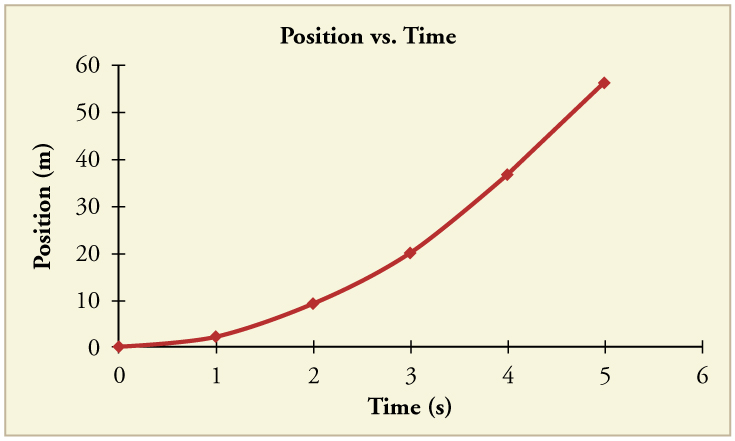
2:
38.9 m/s (about 87 miles per hr)
4:
(a)[latex]\boldsymbol{16.5\textbf{ s}}[/latex]
(b)[latex]\boldsymbol{13.v\textbf{ s}}[/latex]
(c)[latex]\boldsymbol{-2.68\textbf{ 1000/s}^2}[/latex]
six:
(a)[latex]\boldsymbol{20.0\textbf{ m}}[/latex]
(b)[latex]\boldsymbol{-one.00\textbf{ yard/southward}}[/latex]
(c) This result does non really brand sense. If the runner starts at 9.00 m/s and decelerates at[latex]\boldsymbol{ii.00\textbf{ m/southward}^2}[/latex], so she will have stopped after 4.l s. If she continues to decelerate, she will exist running backwards.
8:
[latex]\boldsymbol{0.799\textbf{ m}}[/latex]
10:
(a)[latex]\boldsymbol{28.0\textbf{ m/s}}[/latex]
(b)[latex]\boldsymbol{fifty.9\textbf{ s}}[/latex]
(c) 7.68 km to accelerate and 713 chiliad to decelerate
12:
(a)[latex]\boldsymbol{51.4\textbf{ m}}[/latex]
(b)[latex]\boldsymbol{17.1\textbf{ southward}}[/latex]
xiv:
(a)[latex]\boldsymbol{-80.4\textbf{ m/due south}^2}[/latex]
(b)[latex]\boldsymbol{9.33\times10^{-2}\textbf{ s}}[/latex]
16:
(a)[latex]\boldsymbol{7.seven\textbf{ one thousand/due south}}[/latex]
(b)[latex]\boldsymbol{-xv\times10^2\textbf{ k/s}^2}[/latex]. This is about 3 times the deceleration of the pilots, who were falling from thousands of meters high!
18:
(a)[latex]\boldsymbol{32.6\textbf{ m/s}^2}[/latex]
(b)[latex]\boldsymbol{162\textbf{ m/s}}[/latex]
(c)[latex]\boldsymbol{v>v_{max}}[/latex], because the assumption of constant acceleration is not valid for a dragster. A dragster changes gears, and would accept a greater acceleration in first gear than second gear than third gear, etc. The dispatch would exist greatest at the commencement, so it would not exist accelerating at[latex]\boldsymbol{32.vi\textbf{ m/s}^2}[/latex]during the last few meters, but essentially less, and the final velocity would be less than 162 one thousand/south.
twenty:
104 s
21:
(a)[latex]\boldsymbol{v=12.2\textbf{ grand/southward}}[/latex];[latex]\boldsymbol{a=four.07\textbf{ m/s}^two}[/latex]
(b)[latex]\boldsymbol{v=11.2\textbf{ m/s}}[/latex]
0 Response to "What Is the Minimum Stopping Distance for the Same Car Traveling at a Speed of 36.0 M/s ?"
Post a Comment